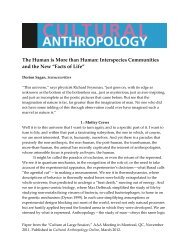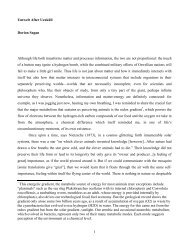PESTICIDES IN COCA-COLA AND PEPSI - Cultural Anthropology
PESTICIDES IN COCA-COLA AND PEPSI - Cultural Anthropology
PESTICIDES IN COCA-COLA AND PEPSI - Cultural Anthropology
You also want an ePaper? Increase the reach of your titles
YUMPU automatically turns print PDFs into web optimized ePapers that Google loves.
CULTURAL ANTHROPOLOGY 22:4<br />
666<br />
The proliferation in the market of global brands following the opening up of the<br />
economy was touted as a major achievement. This was no accident as one of the<br />
most commonly used justifications for liberalization was that the state control of the<br />
economy, by stifling competition, had led to inefficient monopolies and consequently<br />
the lack of “quality” products in the market. It is important, however, to consider<br />
the meaning of quality in relational terms, rather than simply as a set of moreor-less<br />
objective intrinsic product attributes. For instance, the country of origin of<br />
commodities became a rallying point for quality concerns. The global power brands,<br />
of which Coca-Cola and Pepsi are exemplars, came to be prized because of their<br />
scarcity and for their alluring whiff of forbidden lifestyles in exotic locales. Products<br />
from “abroad”—in the preliberalization era, mostly smuggled or procured through<br />
social and family networks and, therefore, highly restricted in their availability—<br />
were considered benchmarks of quality. Therefore, the liberalization of the economy<br />
and the flooding in of the foreign MNCs were perceived as being synonymous with<br />
the coming home of “abroad” (Fernandes 2000a:614) or, in other words, progress.<br />
Local products in this scheme of thinking become proxies for provincialism,<br />
whereas penetration by global brands indicates the desirable “global convergence<br />
around Western values and consumption patterns” (Applbaum 2000:260). In this<br />
narrative of empowerment, evolution in consumer taste is presented as being in<br />
sync with “innate universal psychological tendencies that transcend local culture”<br />
(Applbaum 2000:260). Brands thus become ideal vehicles for transcending the disabling<br />
effects of historical legacies. The result is that the pathologies of place appear<br />
surmountable through consumption and “the . . . boundaries between citizenship<br />
and consumerism are blurred” (Mazzarella 2003:34).<br />
The media, print and electronic, regularly hail the emergence of the “new”<br />
middle classes as a radical and welcome departure from a socialist past of artificial<br />
shortages, enforced austerity, and general dysfunctionality. Mass-mediated imaginaries<br />
(Appadurai 1996; Favero 2003) comprising scripts and models transcend<br />
national narratives and traditions, and play a constitutive role with respect to the<br />
shifting middle-class identity. In this perspective, the “new” middle class, unencumbered<br />
by the shibboleths of a dreary postcolonial past, has finally shrugged off the<br />
contretemps to emerge as the catalyst for historical change. Miller’s insight from<br />
his study of Trinidadian consumers is resonant here: “Their being Trinidadian is increasingly<br />
linked to a sense of their being global, with similar rights and expectations<br />
to those of any metropolitan area” (1997:335). One common example that is often<br />
presented in the print media discussion of the vibrancy of postliberalization India<br />
is the contrast between the current rates of GDP growth, pegged at 7–8 percent,






